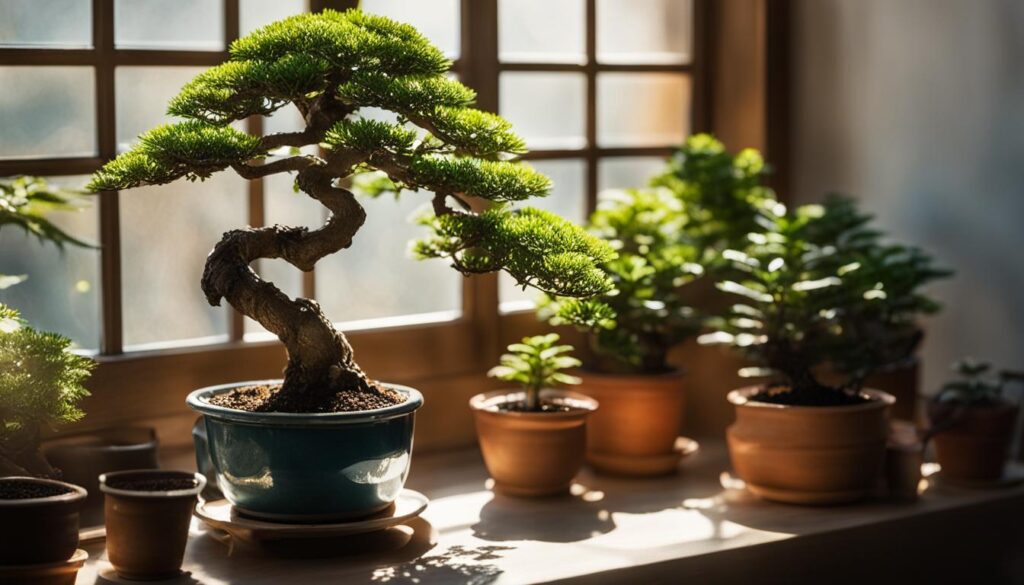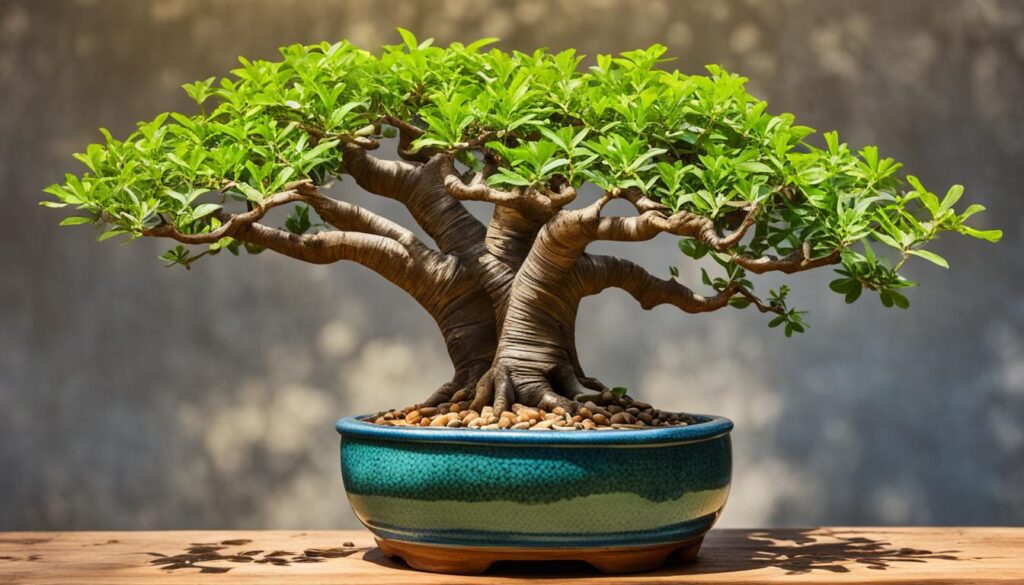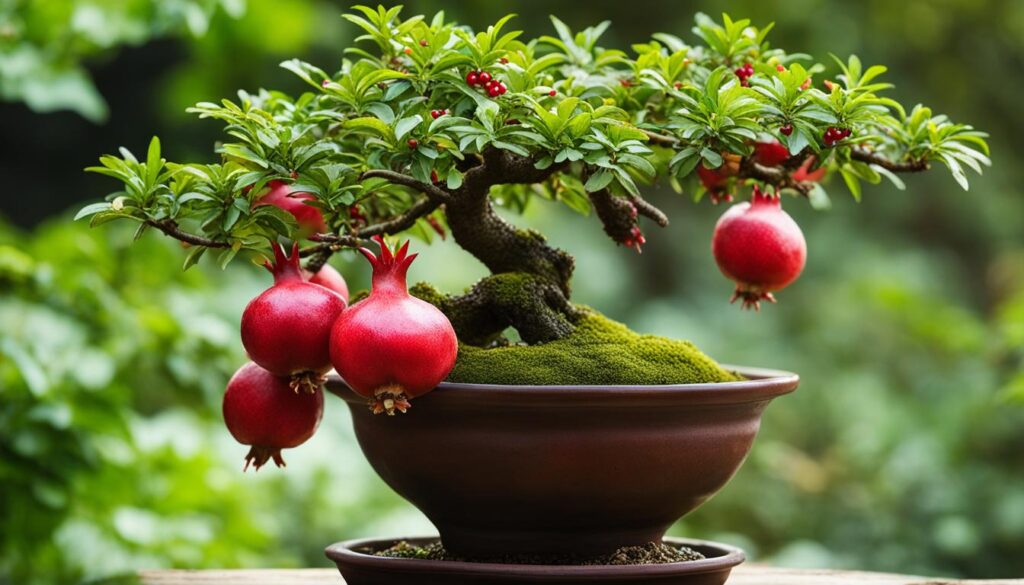Welcome to our guide on caring for your swamp cypress bonsai. This guide covers the key aspects of bonsai tree care. You will learn about the history and origin of the swamp cypress bonsai, as well as techniques for pruning, watering, fertilizing, and re-potting.
If you want to add a touch of nature to your home or are passionate about bonsai, this guide will help you cultivate and care for your swamp cypress bonsai trees.
Understanding Your Swamp Cypress Bonsai
This section discusses the history and origin of the swamp cypress bonsai, also known as Taxodium distichum. We will identify its key traits such as bark, leaves, and cypress knees. We will also compare the swamp cypress with other popular bonsai tree species.
The History and Origin of Taxodium distichum
The swamp cypress bonsai tree, or Taxodium distichum, is native to the southeastern United States. It grows in wetland areas like swamps and marshes. This tree has been cultivated for centuries, with its bonsai form originating in ancient Japan. The swamp cypress bonsai is known for its beauty and unique features.
Identifying Characteristics: Bark, Leaves, and Cypress Knees
The bark of the swamp cypress bonsai is distinctive. It starts out reddish-brown and turns grayish-brown as it ages. Its fibrous texture adds visual interest to the bonsai.
The leaves are needle-like and initially bright green. As the seasons change, the leaves turn bronze or reddish-brown before falling in winter. This seasonal change enhances its appearance.
Another unique feature of the swamp cypress bonsai is the cypress knees. These structures emerge from the roots, adding depth to the bonsai’s design. Cypress knees help stabilize the tree and support water absorption.
Comparing Swamp Cypress with Other Bonsai Species
The swamp cypress bonsai is unique among bonsai trees. While it shares some traits with other species, it also has distinct qualities. Compared to other bonsai tree species, the swamp cypress is known for its:
- Ability to thrive in wetland conditions
- Seasonal color changes
- Appealing fibrous bark
- Presence of cypress knees
These features make the swamp cypress bonsai a great choice for bonsai enthusiasts looking for a tree with unique characteristics.
Where to Place Your Bonsai for Optimal Growth

Proper placement is crucial for the growth of your swamp cypress bonsai tree. Consider its sunlight needs, protection from extreme weather, and humidity levels.
When choosing a location for your bonsai, remember these tips:
- Place your bonsai in an area that receives ample sunlight. Most bonsai trees, including the swamp cypress, thrive in bright, indirect light. Avoid direct sunlight to prevent leaf burn.
- Protect your bonsai from extreme weather conditions, such as strong winds and frost. Place it near a wall or in a sheltered area to shield it.
- Maintain the right humidity for your bonsai. Ideal humidity for most bonsai trees, including swamp cypress, is between 40% and 60%. Increase humidity by placing a tray of water near your bonsai or using a humidifier in dry conditions.
By choosing the right placement for your bonsai, you can provide it with optimal conditions for growth and long-term health.
Watering Cypress Bonsai Trees
Proper watering is essential for the health of your swamp cypress bonsai tree. This section provides guidelines for effective watering and maintaining the right moisture level.
Watering frequency depends on factors such as climate, humidity, and pot size. Generally, water your swamp cypress bonsai regularly, allowing the soil to dry slightly between waterings. This ensures roots receive hydration without becoming waterlogged.
When watering, avoid pouring water directly on the leaves. Water at the base of the tree to allow moisture to seep into the soil and reach the roots. This fosters deep root growth and prevents leaf damage.
Avoid overwatering your swamp cypress bonsai. Overwatering can cause root rot and other issues. It’s better to underwater than overwater. Roots need both water and oxygen to thrive.
To check when to water, insert a wooden chopstick or your finger into the soil. If it comes out slightly damp, wait to water. If it is dry, it is time to water.
As a beginner, maintain a watering schedule and monitor moisture levels. This will help establish a routine that suits your bonsai.
Each bonsai tree is unique, and its water needs may vary. Pay attention to your swamp cypress bonsai’s specific requirements and adjust your routine accordingly.
Nourishing Your Bonsai: Fertilizing Techniques
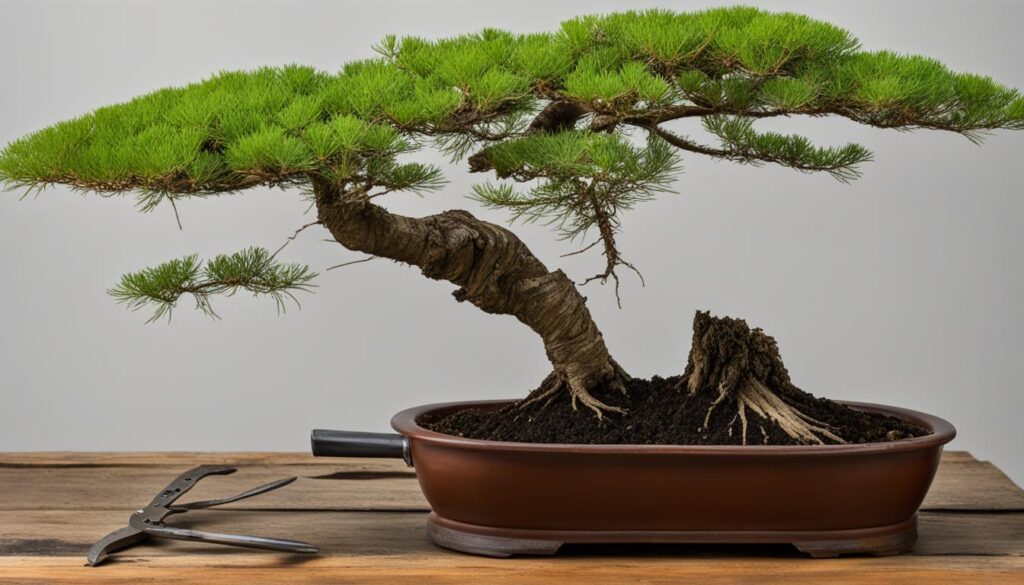
Fertilizing provides essential nutrients to your swamp cypress bonsai tree. Proper fertilization promotes health and growth.
When fertilizing, choose a well-balanced, slow-release fertilizer with nitrogen, phosphorus, and potassium.
Fertilize during the growing season, typically from early spring to late summer or early fall. This is when your bonsai needs nutrients the most.
Follow the instructions on the fertilizer packaging. Apply the correct amount to avoid overfertilization, which can harm your tree. Water your bonsai before and after fertilizing to help nutrients penetrate the soil.
Tip: Consider using organic fertilizers. They come from natural sources and improve soil quality, benefiting your swamp cypress bonsai.
In conclusion, fertilizing your bonsai is crucial. By selecting the right fertilizer, timing your application, and applying it correctly, you can provide your swamp cypress bonsai with the nutrients it needs for healthy growth.
| Fertilizing Techniques for Swamp Cypress Bonsai |
|---|
| Choose a well-balanced, slow-release fertilizer |
| Fertilize during the growing season (early spring to late summer/early fall) |
| Follow fertilizer instructions; avoid overfertilization |
| Water bonsai before and after fertilizing |
| Consider using organic fertilizers for improved soil quality |
Maintaining Shape and Health: Pruning and Wiring
Pruning and wiring are key techniques for maintaining your swamp cypress bonsai’s shape and health. Proper techniques enhance the tree’s appearance.
Prune during the dormant period, typically in late winter or early spring. Start by removing dead or damaged branches to promote healthy growth. Use sharp, clean pruners for precise cuts that heal quickly.
Analyze your tree’s structure and envision the desired shape. Prune branches to maintain form and proportions. Regular pruning prevents overcrowding and allows sunlight to reach inner branches.
After pruning, consider the tree’s health. Apply a wound sealant to protect from infections. For swamp cypress bonsai trees, which heal well, sealants may not be necessary.
Wiring shapes and styles your bonsai tree. Choose flexible bonsai wire that matches the branch’s thickness. Wrap the wire around the branch, starting from the base and moving up. Ensure the wire is snug but not too tight.
Avoid crossing wires and position them at an angle that creates natural movement. Wiring allows you to create bends and twists. Do not leave the wire on for too long, as it may damage the bark.
Mastering the Re-potting of the Bald Cypress Bonsai
Re-potting is essential for your bald cypress bonsai‘s health and growth. Fresh soil and adequate space for roots create optimal conditions for well-being.
Follow these steps for re-potting your bald cypress bonsai:
- Timing: Re-pot every 2-3 years, ideally in early spring before new growth.
- Preparing the tree: Gently remove the bonsai from its pot, untangling roots and trimming any damaged or excessively long roots.
- Choosing the right soil: Use well-draining soil. A mix of Akadama, pumice, and lava rock promotes healthy root growth and prevents waterlogging.
- Repotting: Place a layer of soil in the new pot. Position the bonsai in the center and fill around the roots, leaving a gap at the top for watering.
- Watering and aftercare: After re-potting, water thoroughly to settle the soil. Place the bonsai in a shaded location for two weeks to reduce stress. Gradually reintroduce it to sunlight while monitoring water needs.
Mastering re-potting is crucial for your bald cypress bonsai‘s vitality. Follow these steps to ensure growth and beauty.
Propagating Your Swamp Cypress Bonsai
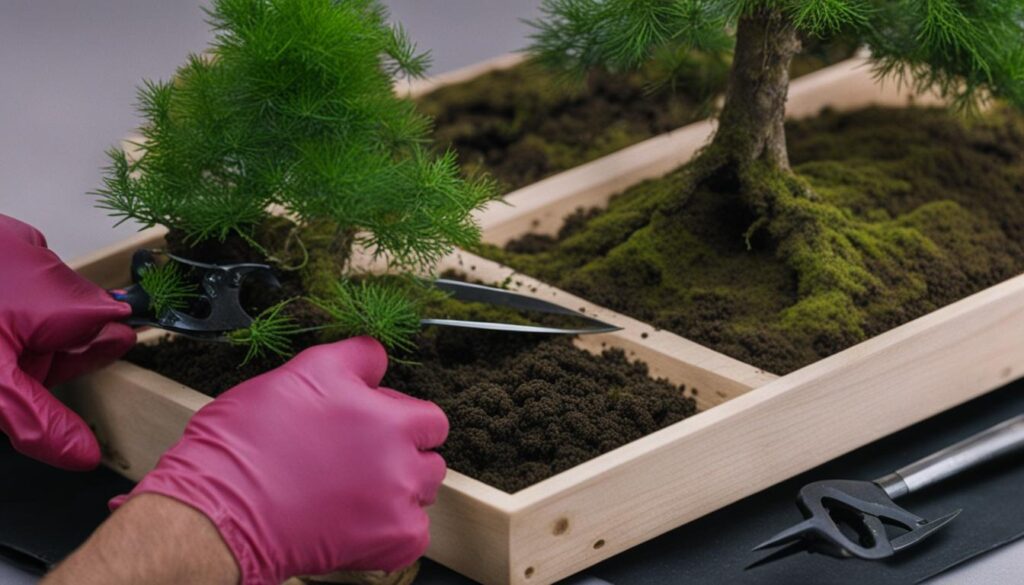
Propagating your swamp cypress bonsai is a great way to expand your collection. This section covers two methods: seeds and cuttings.
To propagate from seeds, follow these steps:
- Harvest seeds from mature cones of the parent tree.
- Clean the seeds to remove debris.
- Soak the seeds in water for 24 hours to enhance germination.
- Prepare a seed tray or small pots with a well-draining soil mixture.
- Plant the seeds about 1/4 inch deep in the soil.
- Place the tray or pots in a shaded area with indirect sunlight.
- Keep the soil moist but not waterlogged.
- Germination takes several weeks to a few months.
- Once seedlings develop, transplant them into individual bonsai pots.
Alternatively, propagate through cuttings:
- Select a healthy branch from the parent tree.
- Cut a 4-6 inch section below a leaf node using sharp pruners.
- Remove the lower leaves, leaving a few at the top.
- Dip the cut end in rooting hormone powder.
- Prepare a rooting medium of well-draining soil or a mix of perlite and peat moss.
- Insert the cutting about an inch deep into the rooting medium.
- Place in a warm, humid environment with indirect sunlight.
- Keep the soil slightly moist.
- Roots develop in a few weeks to a couple of months.
- Once cuttings establish roots, transplant them into individual bonsai pots.
By following these techniques, you can create new swamp cypress bonsai trees and enjoy the art of bonsai.
Pest and Disease Prevention
Protecting your swamp cypress bonsai from pests and diseases is vital for its health. This section discusses common threats and preventive measures.
Pest Prevention:
Common pests include aphids, spider mites, and scale insects. Regularly inspect your tree for pests, such as distorted leaves or sticky residue. If you find pests, remove them manually or use organic insecticidal soap. Maintaining proper watering, fertilizing, and sunlight conditions will strengthen your bonsai’s defenses against pests.
Disease Prevention:
Bonsai tree diseases like root rot and fungal infections can harm your swamp cypress. To prevent diseases, ensure proper drainage with well-draining soil and avoid overwatering. Sanitize your tools before each use to prevent spreading pathogens. If you see signs of disease, such as yellowing leaves or wilting, prune affected parts and apply a suitable fungicide per the product’s instructions.
By prioritizing pest and disease prevention, you can safeguard your swamp cypress bonsai’s beauty and vitality. Regular monitoring and proper care practices will help maintain a healthy bonsai that brings joy for years.
Read about caring for orange tree bonsais! >>>

